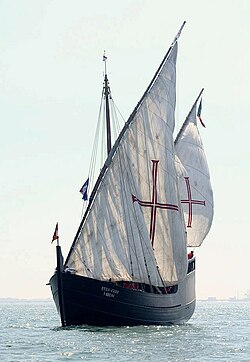Caravel
A caravel is a light sailing vessel used on ocean voyages in the 15th and 16th centuries around Portugal and Spain. She is particularly famous for being two of the ships used by Christopher Columbus on Columbus's First Voyage: the Pinta and the Niña, since the Santa María was a ship.
She was the first to be able to sail against the wind, which allowed her to travel oceanic; if the airs were always contrary (as between Labrador and Greenland, or to cross the tropics). Previous navigation had taken advantage of favorable prevailing winds (for example, the winds to land during the day, and to the sea at night or in the morning).
Etymology
The word seems to have its origins in caravo or carabo, an anglicization of the Greek κάραβος, a light vessel used in the Mediterranean. According to some historians, the word comes from the Arabic carib or "qârib" (medium size ship with triangular sails - Latin canopy). Its first documented use in Portuguese dates from 1255 and the last reference in printed documents dates from 1766, suggesting that the term has been applied to various vessels over time.
Features
They had a light hull and a refined shape, which resulted in a fast boat and suitable for winning windward. Regarding their dimensions, they are believed to have measured 20 to 30 meters in length and 6 to 8 meters in width. wide (beam), of round or lateen rig and with three masts, on a single deck and high sterncastle. They were sailing at about 8 knots (about 15 km/h). They were fast and easily maneuverable.
The caravel allowed the transport of many goods, which makes it possible to feed the crew during long voyages, it does not require rowers and the surface area and the number of sails are increased.
Although the model did not require oars, in the caravels used by Enrique the Navigator or Fernando de Magallanes the deck could house four very long oars, for those cases in which it was necessary, and each one had to be handled by four men who, to move them, they had to walk back and forth on the deck. The ships did not stick out from the sides and rarely had raised forecastles or sterns. Some reproductions show the caravels with three lateen sails. However, they could also only have two.
Round caravel
Many sailors chose to combine the lateen sail with the square sail in the caravel, obtaining a new model known as a round caravel. La Niña and la Pinta were Latin caravels, but shortly before Columbus began his voyage, they were converted into round caravels.
In a headwind (unfavorable), the square sail cannot stick to the wind more than 50% in a well-balanced ship with an experienced crew. It is also easy for this type of ship to drift a lot. However, the lateen sail can follow the wind perfectly and does not drift.
With a (favorable) downwind, the square sail takes full advantage of the wind and advances with a uniform movement. With a lateen sail, the uneven pressure makes it more difficult to stay on the same heading.
History
This boat model was probably based on the boats used by Portuguese fishermen. At the end of the 15th century the Prince of Portugal, Henry the Navigator, undertook a series of conquest explorations on islands in the Atlantic and on the coast of Africa. The invention of the caravel, as well as the replacement of the coca by the nao, greatly aided Spain and Portugal in their ocean voyages in the 18th century XV.
Exploration by caravels made possible the Portuguese and Spanish spice trade. However, for the trade itself, the caravel was later replaced by the larger carrack (nao), which was more profitable for trade. The caravel was one of the pinnacle ships in the Iberian ship development of 1400-1600.
In the years after the discovery and the conquest and colonization of America, the caravels fell into disuse as new types of vessels appeared, especially the galleons, which had the precedent of the ships and carracks, but with enormous improvements in its performance, especially in terms of load capacity, resistance and maneuverability.
Caravels of Columbus
- The girl: Vicente Yáñez Pinzón led 26 men.
- The Pinta: Cristóbal Quintero was the owner of this ship and Martin Alonso Pinzón was in charge, helped by his brother Francisco. From the Pinta (which weighed about 60 tons and had 24 men on board) Rodrigo de Triana divised land on October 12, 1492.
- The Holy Mary: In the Diary of a Bordo of Columbus compiled by Bartolomé de las Casas is spoken of three carabelas, although in some days he uses the word nao. It is possible that the use of this word is synonymous with shipping or because it was a ship, which is a boat model greater than a carabela. In any case, Francisco López de Gómara warns that it was a larger carabela than the others. Columbus rented this ship to Juan de la Cosa, a cantabrian shipowner, and commanded it with another name, that of Santa Maria. According to some sources the ship had been built in Galicia, and that is why it was called La Gallega, although other sources say the ancient name of the ship was the Marigalante (or, also, according to sources, Maria Galante).
Contenido relacionado
1004
549
1390



